1896 Porthywaen Lime Company. Savin and Company had by now absorbed small companies or they were closed down. Captain Nicholson formed the Porthywaen Lime Company.
At this time the company was leasing the Dolgoth quarrry Nr Llynclys but did not renew the the lease when it fell due in 1896.
1900's Porthywaen Lime and Basic Company Ltd. Over the years other companies had offices at Porthywaen. Among these were the Whitehaven Basic Company Ltd and the Welshpool Standard Granite Company Ltd.
1932 The Porthywaen Lime company taken over by The Steetley Lime and Basic Company Ltd.
1932 Steetley Lime and Basic Company Ltd.
|
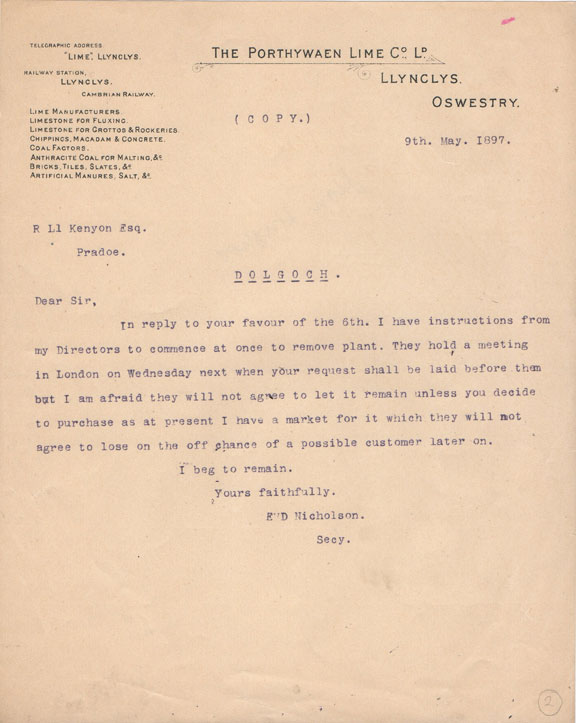
|
Porthywaen Lime Company letter dated 1897
Thomas Savin the Mid Wales entrepreneur was one of the directors,the company also had workings at Llanymynech. The company had an office situated at Llynclys by the now White Lion Inn.Letter heads stated Porthywaen and LLanymynech Limestone works Savin & Company.
Source Ron Hughes
|
|
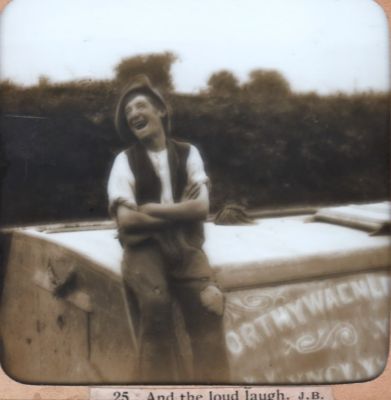
|
1897 The Porthywaen Lime Company was looking for some suitable canal boats and were offered two Stag and Cupid for £28. This glass 'lantern slide' was one of 50 found in the north of England most of scenes of India, but this one was amongst them. It shows an unknown man sitting on the side of a barge belonging to the Porthywaen Lime Co of Llynclys. This would have been one of the two boats purchased by Thomas Savin and operated from the Crickheath Wharf. Can anyone name this man?
Source Ken Owen. |
|
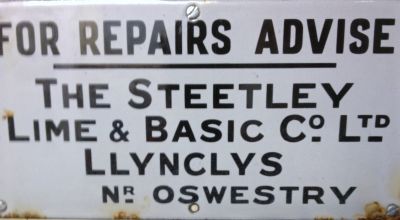
|
Metal sign displayed in Cambrian Railways Museum, Oswestry.
Source Ken Owen. |
|
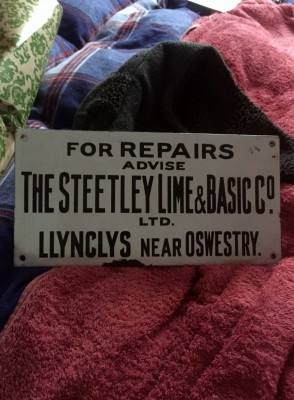
|
Another "Steetley" sign found very recently (Dec 2016) in a former Cambrian Railways fireman's bedroom who had "recovered" the sign from the lineside into Steetleys quarry at Porthywaen when the railway closed in the 1960.s and had kept the sign in his bedroom cupboard ever since.
Source Ken Owen |
|
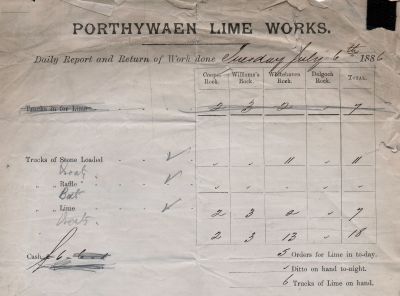
|
Source Ron Hughes |
|
.jpg)
|
Letter from the Cambrian Railways(Llynclys Station) dated 10th December 1896 addressed to Mr Nicholson with regard to movement of railway wagons.
Source Wilf Jones. |
|
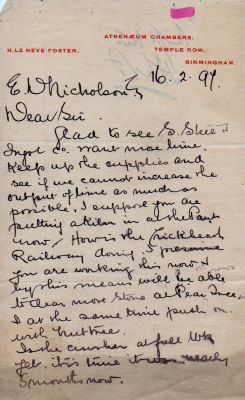
|
Letter dated 1897 to Mr Nicholson enquiring about his operation Nantmawr lime kilns and also the Crickheath Tramway.
Source Ron Hughes. |
|
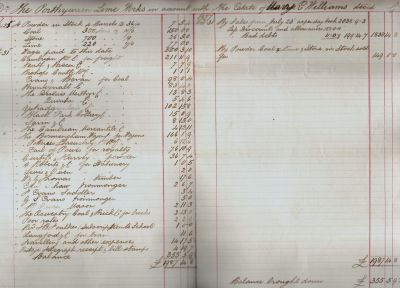
|
Accounts sheet for Porthywaen Lime Works dated 1877 on the death of the owner Mrs Mary Williams.
Source Ron Hughes. |
|
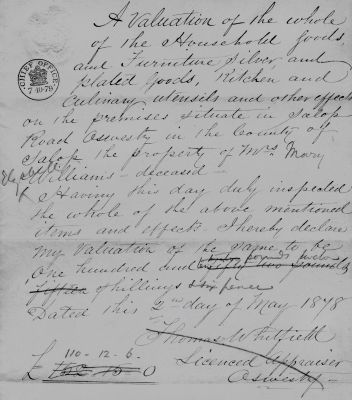
|
Valuation document of the contents of Mary Williams house in Salop Road Oswestry, dated 2nd May 1878. Contents valued at £112.12s &6d.
Source Ron Hughes. |
|

|
3 page document dated May 1876 by Mineral Surveyor describing the business of Mary Williams (Porthywaen Lime and Fluxingstone Works) and giving a valuation of that business
Source Ron Hughes. |
|
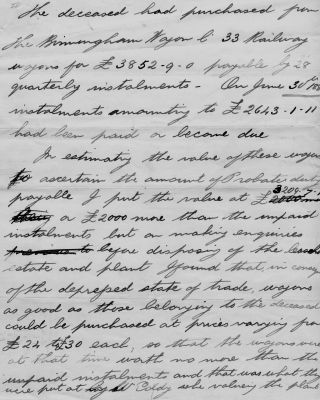
|
Valuation certificate dated 30th June 1880 of 33 Railway wagons purchased by Mary Williams from the Birmingham Wagon Co
Source Ron Hughes. |
|
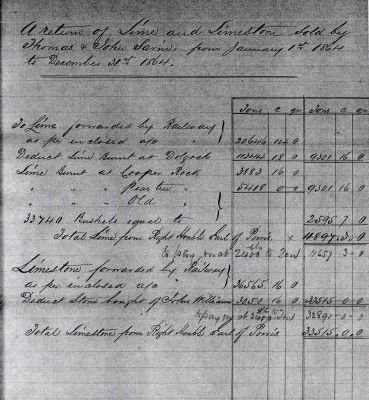
|
Document showing a breakdown of Limestone obtained and Lime burnt from Dolgoch Quarry, Coopers Rock, Pear Tree Quarry and also 33,740 buckets of rock giving a total of 33,515 tons for the year of 1864. This is for Thomas Savins Company.
Source Ron Hughes. |
|
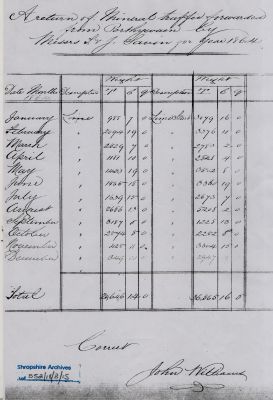
|
Document showing mineral supplies forwarded from Porthywaen for the year 1864 by Savins Company
Source Ron Hughes. |
|
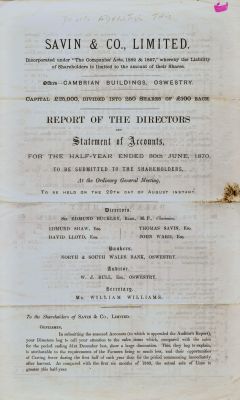
|
Savin & Co statement of Accounts dated 1870
Source Ron Hughes. |
|
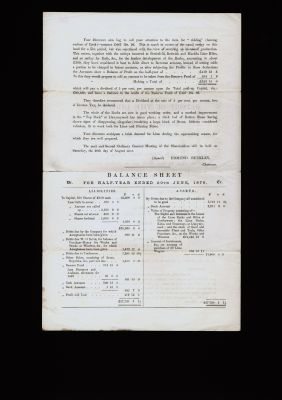
|
Page 2 of above document.
Source Ron Hughes. |
|
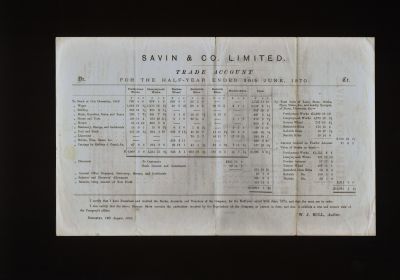
|
Page 3 of above document .
Source Ron Hughes. |
|
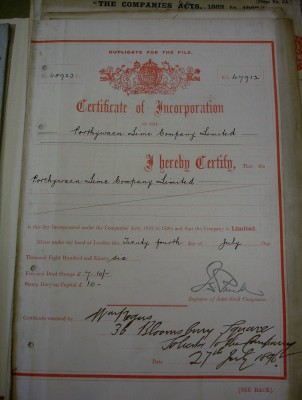
|
Photo of the Certificate of Incorporation of the Porthywaen Lime Company Ltd dated 1896.
Source Ken Owen |
|
.jpg)
|
Inside cover of a ledger dated 1st October 1885 through to 1890 showing deliveries of stone and raffle from the limestone quarry at Porthywaen. This book is believed to have been used in the office of Thomas Savin & Co at Llynclys and was amongst a load of documents that were rescued by a quarry worker when Steetley emptied their office and told a worker to burn all the "rubbish".
Source Ron Hughes. |
|
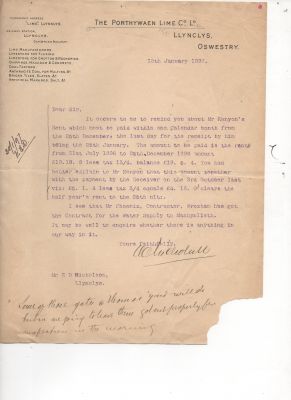
|
Source Ron Hughes. |
|
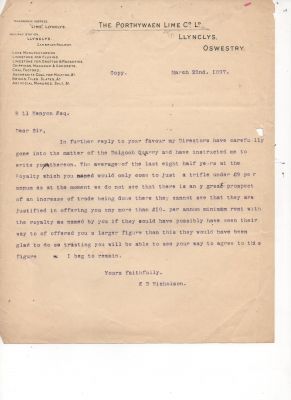
|
Source Ron Hughes. |
|
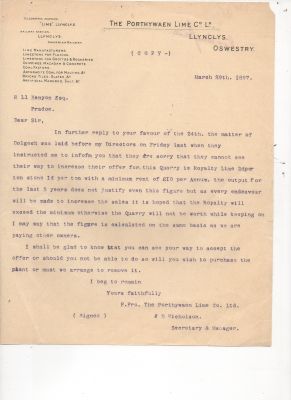
|
Source Ron Hughes. |
|
.jpg)
|
|
|
.jpg)
|
|
|

|
Photo of a Porthywaen Lime Co 10 ton wagon parked in a siding at Porthywaen, date unknown. Many of the early wagons had wooden underframes, some with dumb-buffers, whilst later wagons had steel channel underframes. An interesting relic to be seen at Porthywaen until the early 1960's was a dumb-buffered open wagon with a "primitive roof". The foreman at the works stated in 1952 that it was used for the storage of salt and had been standing in the same place for 50 years.
When Savin & Co. became part of the Porthywaen Lime Co, 6 wagons were sent to Saltney to be relettered. Unfortunately, this was not done properly but the company accepted the wagons. In the early style lettering, the firms name occupied the top plank but later the name was given more prominence. |
|
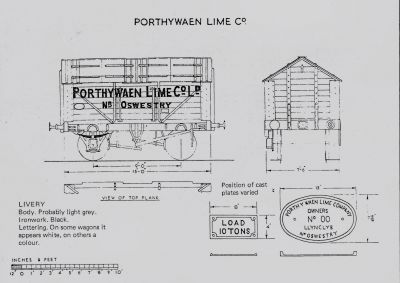
|
Dimension diagram of Porthywaen Lime Co Covered wagon. |
|
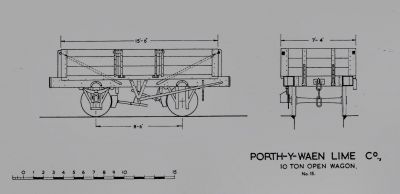
|
Diagram of open 10 ton Lime wagon. |
|
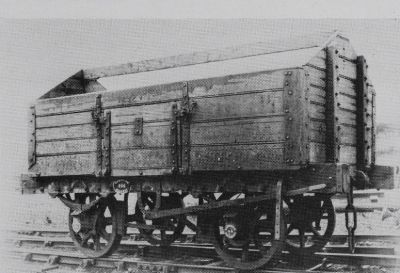
|
Built by the Midland Wagon Co. around 1864 for £62.10s this dumb-buffered wagon survived at Porthywaen until 1900 This would have been one of the 33 wagons that Mary Williams purchaced from The Birmingham Wagon Co. (See valuation certificate above). |
|
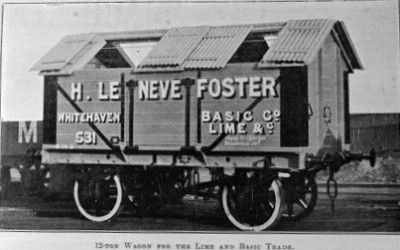
|
Interesting photo of one of the lime wagons of the Whitehaven Basic Lime Co which later became Steetley Lime & Basic Co. It is also interesting that it was lettered with the name of one of the Directors of the company H.LE NEVE FOSTER. Date not known.
Source Ken Owen |
|

|
Lettering and dimensions of the Steetley Lime & Basic Co. 10 ton covered Lime Wagon. The company lettered the wagons S.L.B from 1932 to 1944, then Steetley Co Ltd was used. |
|

|
Photo of a covered (Cottage Top) 10 ton Lime wagon in a siding at Porthywaen, note the chimney in the background in Pear Tree Quarry which is a familiar landmark in the area today. The photo would be after 1944 - the date the Steetley Co Ltd was formed. |
|
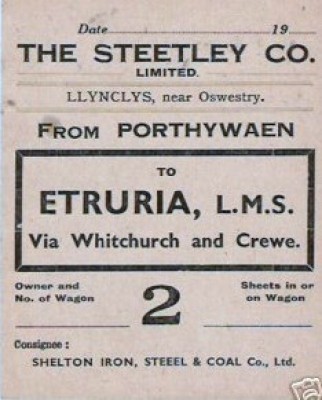
|
Copy of a cardboard label which was slotted into a spring loaded container on the side of the loaded lime wagon before shipment to the steel works.
Source Ken Owen |
|
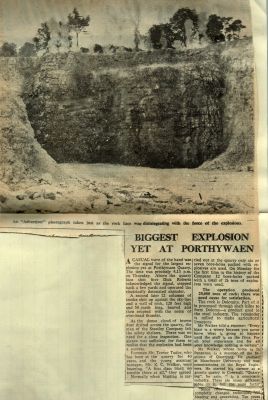
|
Abvertizer report on a large explosion at Porthywaen Quarry. |
|
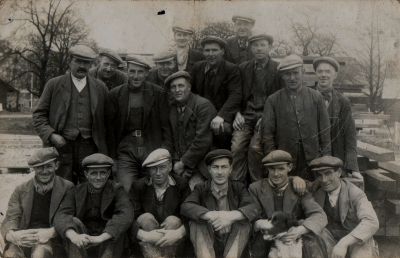
|
Early photo of workers at Porthywaen Quarry 1930's.
Source David Higman. |
|
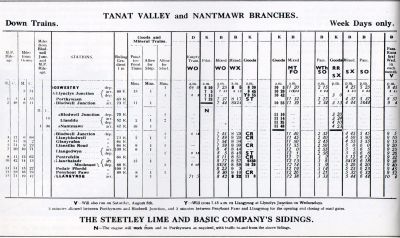
|
Railway timetable for operations into the Porthywaen quarry. |
|
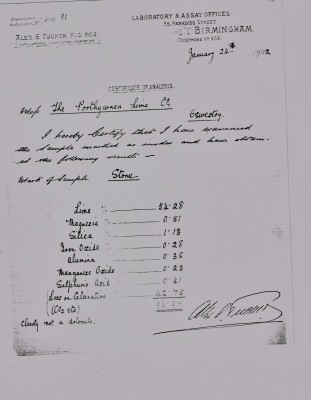
|
Interesting copy of letter from Laboratory in 35 Paradise Street Birmingham dated 24th January 1902. It is a Certificate of Analysis of a piece of rock sent obviously by Porthywaen Lime Company. The analysis shows the contents of the rock sample, analysed by the Chemist Alex E Tucker. who stated that the rock sample was definitely not Dolomite.
Source David Higman |
|
|
|
|
|
|